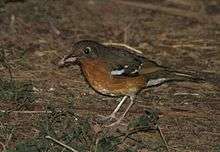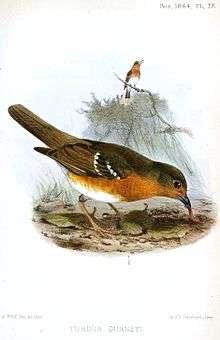Orange ground thrush
| Orange ground-thrush | |
|---|---|
 | |
| Scientific classification | |
| Kingdom: | Animalia |
| Phylum: | Chordata |
| Class: | Aves |
| Order: | Passeriformes |
| Family: | Turdidae |
| Genus: | Geokichla |
| Species: | G. gurneyi |
| Binomial name | |
| Geokichla gurneyi (Hartlaub, 1864) | |
| Synonyms | |
|
Zoothera gurneyi | |
The orange ground-thrush (Geokichla gurneyi) is a species of bird in the family Turdidae. It is found in eastern and southern Africa.[2]
Taxonomy

The orange ground-thrush was described as Turdus gurneyi by Hartlaub in 1864.[3] It is named after John Henry Gurney Sr., an English banker, politician and ornithologist.[4] There are five subspecies: G. g. chuka found in central Kenya; G. g. raineyi found in southeastern Kenya; G. g. otomitra found in western Angola, southeastern Democratic Republic of the Congo, Tanzania, and northern Malawi; G. g. gurneyi found in eastern South Africa; and G. g. disruptans found in central Malawi to northeastern South Africa.[2]
Distribution and habitat
This thrush is found in Angola, Democratic Republic of the Congo, Kenya, Malawi, Mozambique, South Africa, Swaziland, Tanzania, Zambia, and Zimbabwe.[1] The size of its range is estimated at 424,000 km2 (164,000 sq mi).[1] It is found at elevations of 500–2,500 m (1,600–8,200 ft).[1] Its habitat is montane forests.[3]
Description
Its length is 21–23 cm (8.3–9.1 in). The male weighs 44.5–64.5 g (1.57–2.28 oz), and the female weighs 48.5–76 g (1.71–2.68 oz).[3] The upperparts are olive-brown; some parts have a grey tinge.[3] The flight feathers are blackish-brown. There are two bars on the wing.[3] The throat, breast and flanks are orange. The vent is white. There is an incomplete white eye-ring.[3] The beak is dark.[5] The legs are pink.[3] The female is similar to the male but is less bright.[3] The immature has mottled underparts.[5]
Behaviour
The orange ground-thrush is crepuscular.[3] It is sedentary, but makes altitudinal movements in some regions.[6] Its call is tsip and cureek. Its song is a series of several mellow and melodious notes.[3] It feeds on the ground. Its diet is earthworms, insects, molluscs and fruits.[3] The breeding season is January to May in Kenya, August to December in Tanzania, October to January in Malawi, and September to December in Mozambique, South Africa and Zimbabwe.[3] In breeding pairs, the female has been observed to consistently weigh more than the male.[3] The nest is a deep cup built of moss, twigs, leaves, roots and ferns.[3] There are 2 to 3 turquoise-blue eggs.[3] The eggs are incubated for 15 days. The fledging period is 18 to 20 days.[3]
Status
Its population size is not known.[1] Its population is declining because of habitat loss. The IUCN Red List has listed the species as least concern because it has a large range and its population is not declining quickly enough for it to be considered vulnerable.[1]
References
- 1 2 3 4 5 6 BirdLife International (2012). "Zoothera gurneyi". IUCN Red List of Threatened Species. Version 2013.2. International Union for Conservation of Nature. Retrieved 26 November 2013.
- 1 2 Gill, F.; Donsker, D. (eds.). "Thrushes". IOC World Bird List Version 6.4. Retrieved 5 November 2016.
- 1 2 3 4 5 6 7 8 9 10 11 12 13 14 15 16 Clement, Peter; Hathway, Ren (2010). Thrushes. Bloomsbury. pp. 244–245. ISBN 9781408135419.
- ↑ Jobling, James A. (2010). Helm Dictionary of Scientific Bird Names. Bloomsbury. p. 181. ISBN 9781408133262.
- 1 2 Newman, Kenneth (2002). Newman's Birds of Southern Africa. Struik. p. 332. ISBN 9781868727353.
- ↑ The Atlas of Southern African Birds (PDF). p. 159.
